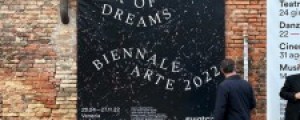Random Institute: Interview with Sandino Scheidegger
Would you explain, in a few words, what Random Institute is?
Random Institute is many things for many people. It’s all about perception, and most people perceive it as an institution that generates unlikely encounters between artists and audiences.
For me personally, it represents a decade-long series of private conversations with Luca Müller, who co-founded Random Institute with me in 2007. Our goal has always been to regain time for reflection and debate, something we feel is often lost in today’s fast-paced world. Some of the conversations we’ve had over the years have translated into curatorial projects, publications, or journeys with artists.
Last time we counted, it was about 80 projects. However, as the projects got bigger over the years, we slowed down the pace. We’re doing about four to five projects per year now. What Random Institute stands for continues to change over time also. It’s redefined and shaped by our ongoing conversations.

A performance by artist Linda Tegg at a stranger’s home in Brooklyn, New York. The host gave in exchange their personal belongings to Fresh Window Gallery over duration of the exhibition
In the brief description I read on your website, you talk about Random Institute as “an extension of what a contemporary art institution can be.” I am curious of your definition of an art institution.
Historically, art institutions were responsible for making art accessible to audiences and for providing space for discourse. Hand on heart, these tasks have largely been taken over by the Internet and digital platforms. Art it is now often presented through a mediated form and online research can precede the real experience of art. In fact, today online visitors to art institutions outnumber real visitors.
Luca and I are big advocates of the idea that the digital world will never substitute reality. However, the shift to spending more and more time in the digital sphere is here to stay. And while I do think art institutions should invest time and thought into how they want to be perceived online, this shift to digital can also be a chance for institutions to adapt and start providing what the bits and bites can’t: real social touch-points and a place that brings people together who wouldn’t otherwise meet. Basically, my definition centers on the institution functioning as a social place as much as a place in which to discover art with other people, it’s the opposite of sitting alone in front of a screen.
What sets you apart from other art institutions?
If there is something that sets us apart from other art institutions, it’s probably time. We’ve got plenty. This sounds weird, but it is really what we believe in and fight for. Time for reflection and debate is what seems lost today.
Because we prioritize time, our professional and personal approaches probably differ from many of our art-world colleagues. For instance, we make it a point to always spend more time reading newspapers than writing emails each day. Also, every other year we designate exhibition-free time when we turn our focus away from art (Luca, for example, is currently spending four months in the Alps taking care of 80 cows).
In the past, these intentional, exhibition-free times have become the source of some of our larger projects like the founding of the Kunsthalle Tropical and Réunion, as well as the crossing of the Atlantic. During the downtime, we reduce the all administrative tasks that build up from exhibition to exhibition and we have time to think and conceive of new initiatives.

Artist Renaud Loda performing and retracing an art space on a cargo boat. Somewhere in the Atlantic.
Do your «random» ideas arise just from the curatorial side, or do you conceive projects and exhibitions through a dialogue with the artists you want to collaborate with?
There are two main ways in which we currently develop our projects. One is, as you mention, conceiving projects in dialogue with other people—both artists and non-artists—who we find inspiring because of their unique work, how they think, or their particular way of perceiving things. Of course, an individual’s personality, interests, and activities also play important roles in our decision to collaborate. Like Charly, a local celebrity from Paris who has an intriguing double life. At night he roams the street as a drag queen and during the day he is a Michelin-award-winning fish monger. We were interested in Charly’s dual talents, so we invited him to open his fish store at our former art space in Zurich and programmed two days of queer performances in the middle of the fish market.

Various performances during the two day festival within a fish market at the art space Réunion in Zurich
The other way that we develop our projects is more organic. About one half of them originate randomly, often in silence while reading daily newspapers. Luca and I dedicate four mornings per week to thoroughly reading newspapers and making connections between articles, events, opinions, editorials, and images. Through this process, we often develop ideas that you might describe as “arising from the curatorial side,” as they might become the point of departure for a new exhibition, installation, or initiative. This was the case for Consider Yourself Invited, for which we invited two North African artists to Switzerland to speak about their work. Reflecting current immigration issues, one of the invited artists met the necessary visa requirements to enter the country and the other one didn’t, forcing us to confront a real life-situation, as opposed to a conceptual curatorial scenario.
Additionally, every now and then a specific artwork inspires us to take action. This happened with Guido van der Werve’s video Nummer veertien, home (2012), which motivated us to conceive of a road-trip project from Paris to Warsaw.
In 2013, the Random Institute decided to co-found the contemporary art center Réunion in Zurich and the Kunsthalle Tropical in Iceland. I tried to “explore” the website of the latter, and I found another interesting way to describe this, could we call it, space? You write about it as a “field of projection and a Social Sculpture.” Could you describe it? And why did you decide to give this name to the project?
Réunion and Kunsthalle Tropical are both very different projects. Réunion was born out of a curiosity to see how four art-oriented individuals and organizations, all of very different sizes (a curator, single artist, entire university, and us), might work together. We were interested in finding out what kind of conversations would be produced, especially since each participant has entirely different demands and applications for a shared art space.
The Kunsthalle Tropical is an art institution that’s located in the rocky desert of Iceland—it rises only a few centimeters above ground. Artists, curators, and the public are invited to find the Kunsthalle by its coordinates. The concept for the Kunsthalle Tropical was born out of a discussion with the Swiss artist Marcel Meury about how one thing can be or mean two different things for two different people, and how works of art and curatorial projects can overlap, as they often have similar starting points, like questions of authorship and relationship with the public. In this way, the Kunsthalle can be seen both as a curatorial and an artistic project, depending on who you ask, Marcel or me.
“Field of projection” comes from a personal claim I like to make that some places that are better visited in the imagination than in real life. This is a long train of thought making up an entire book, which I wrote by hand a few years back and buried below the Kunsthalle Tropical. The “Social Sculpture,” meanwhile, was Joseph Beuys’s idea about how we shape the world in which we live, as well as about how art is an evolutionary process that takes time and human activity. Marcel was interested in connecting this concept to the open possibilities of the Kunsthalle Tropical.

Image by photographer Juliette Chrétien during the research in Morocco for the project Consider Yourself Invited
Your curatorial practice seems to consider writing as one of the most important aspects. Am I wrong?
True, in my opinion, writing often holds a project together. Context is not only place and time but can also be thoughts and ideas, which might be best expressed in writing. In addition, Luca and I are always interested in making art accessible beyond physical exhibitions, and a lot of the time this can be most readily achieved and we can reach the largest audience in written form, especially in our Internet age.
Remains to Be Seen at Kunsthalle Tropical and All the Lights We Cannot See in Pyongyang, North Korea, two of your last exhibitions, really caught my attention. Both of the titles are composed throughout the use of the verb “to see,” but, in fact, there’s no-one or nothing to see. Is there any documentation about these two projects? Or is it supposed to not exist at all? Why?
Remains to Be Seen developed during a journey and seminar we led in Iceland. We planned to take nine artists from a Swiss university to the Kunsthalle Tropical to discuss the absence of an audience and its implication on art practice and authorship. We had a beautiful debate about how a place becomes a destination, how some places are probably better imagined than visited in real life, and how the absence of an audience can be an opportunity. Our intention was to send the artists in really small groups to explore the Kunsthalle, but on the day of the trip, the weather turned extremely bad.
When the heavy snowstorm finally settled, we knew that the Kunsthalle Tropical was entirely buried in snow and would be inaccessible, so we decided to condense all the students’ initial ideas for artworks into text form. Instead of visiting the site on foot, we decided to fly over the Kunsthalle in a small airplane and simply read aloud the textual works, ergo all the artwork remains to be seen. The documentation of the piece is minimal, so as not to infringe on the imagination.
All the Lights We Cannot See had a very different genesis and took place in the hermit kingdom of North Korea. We traveled there with the co-curator of the project Anna Hugo, artworks in tow, for a clandestine exhibition in Pyongyang. The world outside North Korea really only perceives and understands this relatively unknowable country through global media sources, and our exhibition was no exception. The artworks and the installation are really only accessible through images, and if anyone inquiries about the exhibition, the artists simply reply, “I’m not supposed to talk about it,” which is meant to further feed global curiosity about the capital of unknown.
You have recently been appointed curator at large at Despacio. The e-flux description defines it as a “driving force in the continued development of Central America’s artistic voice.” What are you currently working on at Despacio?
It’s a balancing act, in a way. On the one hand, I contribute and incorporate many concepts from Random Institute; on the other hand, I try to honor and continue what Despacio has been for almost ten years, one of the most fertile grounds for artistic innovation in Central America.
Despacio was originally established by the artist Federico Herrero with and guided by the belief that there is something positive to be gained by local and international artists speaking to one another. This makes the modus operandi quite simple: I am bringing international artists to Costa Rica for exhibitions and also collaborating with partners in Europe to organize exhibitions featuring Central American artists there. Right now I’m working on a large Central American overview show at Sies + Höke in Düsseldorf, which will open in early 2017.
I’m also currently working with Florence Jung—she’s also known as a kidnapper, Disney princess, luxury goods smuggler, chicken forger, punk stripper, crook, dead academic painter, Marxist nail stylist, and clandestine street seller—on her upcoming solo show at Despacio. She’s a French artist on a quest to make Don Quixote disappear from Costa Rica. She’s buying all the copies in all the bookstores, borrowing all the copies from all the libraries, offering to buy people’s personal copies, and stealing any other copies she has to. Let’s see how this turns out.
by Eleonora Castagna
in Focus on Europe
Jul 19, 2016

























